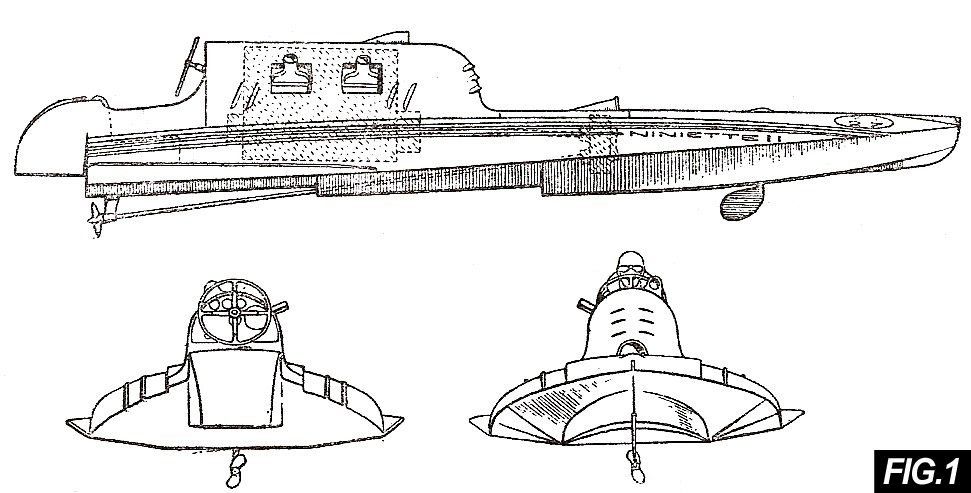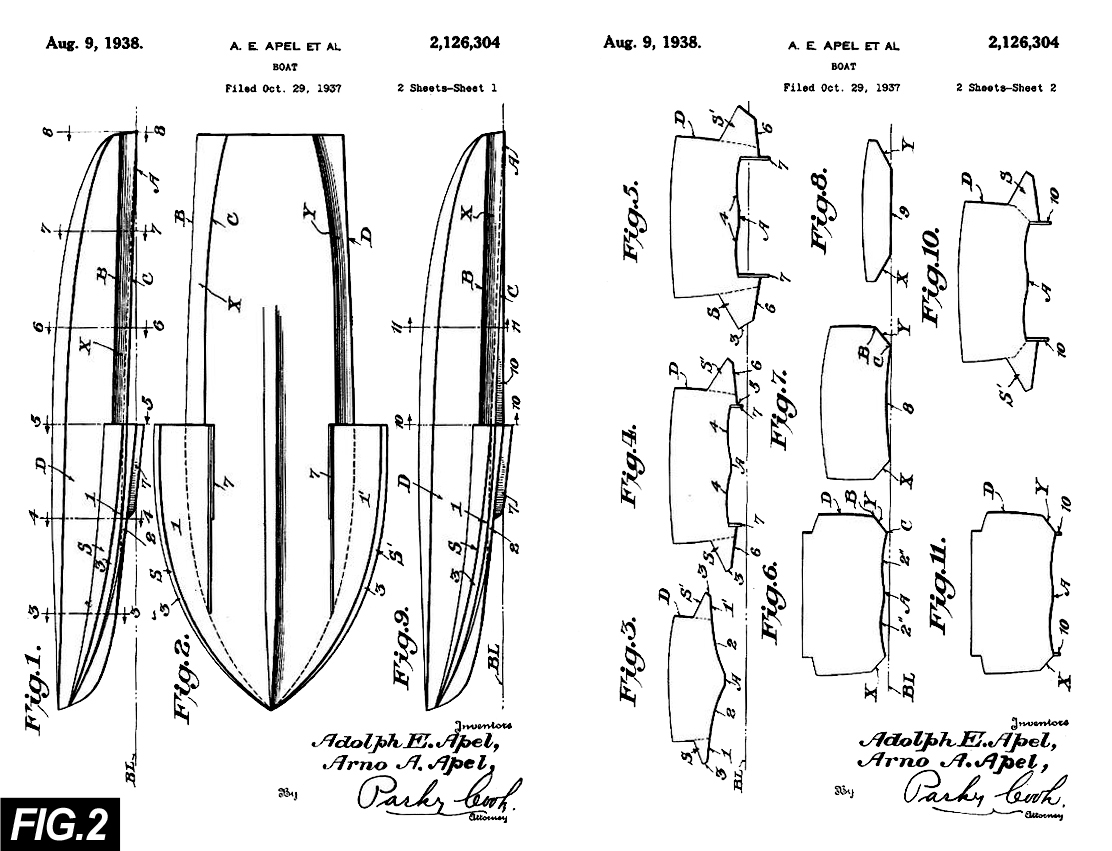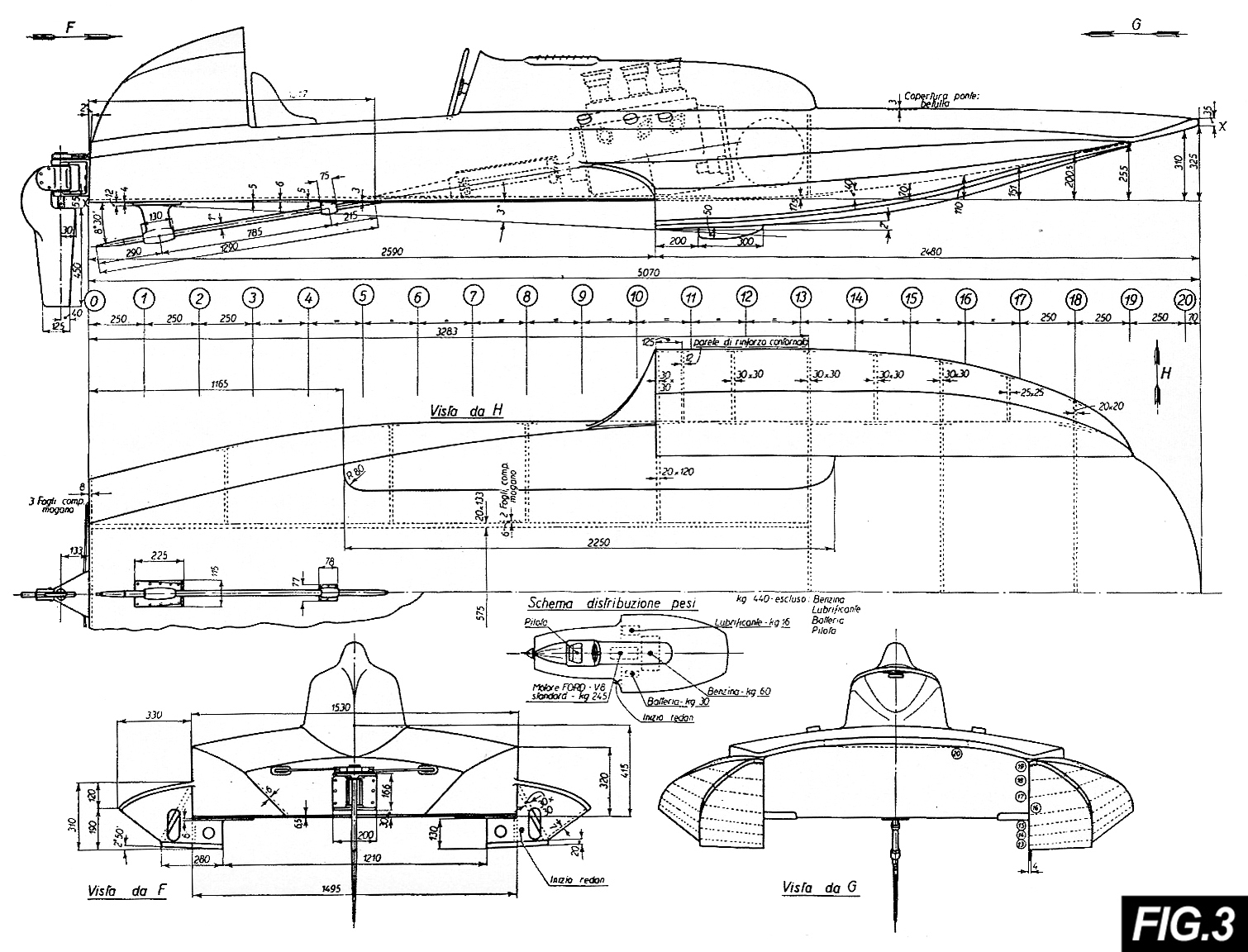The History
In 1903 the Automobile Club de France organized a special international commission in Paris to make the -Racing Motorboats- sector official for the first time in the history of motorboating.The hulls were divided into 2 categories: CRUISER, derived from pleasure boats, and RACER, boats intended only for competitions. Both divided into classes according to their length (at the time it was believed that the speed of the boat increased the longer and narrower it was) and the displacement of the engines.The first powerboat race in Italy was organized in Stresa in September 1903 with 6 participants, of which 3 "launch-cars" (as they called them) officially entered by FIAT: 1 Cruiser and 2 Racers who won most of the races of the weekend. Throughout the world, until the mid-1930s, Inboard-Racers were only of the redans single-hull type, with transmission to the propeller by return and almost all with the rudder positioned forward about 2 meters from the bow (FIG.1).
Throughout the world, until the mid-1930s, Inboard-Racers were only of the redans single-hull type, with transmission to the propeller by return and almost all with the rudder positioned forward about 2 meters from the bow (FIG.1).
Even if already in 1920 the Australian builder Ernie Nunn had experimented with the concept of the 3 points of support on a boat, the great turning point in the technical approach of the Racers (in USA -Hydroplanes-) only occurred in 1936 when they presented themselves, winning immediately competing and breaking records, the revolutionary Ventnor 3 points built by the Apel brothers in the USA, who registered the patent in 1938.
The 3-point Ventnors were basically still single-hulls with a classic front keel, but much modified (FIG.2). They no longer had the redans, the bottom had become slightly concave and ended flat at the stern and, above all, they had 2 lateral boots applied on the sides of the front half of the boat, each provided with a metal fin applied on the final internal side of the boot (until mid 40s, then only one on the left boot). With this configuration the Racer, picking up speed, rose and touching the water only with the final part of the boots and the stern (with the propeller immersed) sailed touching the surface of the water only in 3 points: the forward clutch of the boat in the water it had been enormously reduced!
With this configuration the Racer, picking up speed, rose and touching the water only with the final part of the boots and the stern (with the propeller immersed) sailed touching the surface of the water only in 3 points: the forward clutch of the boat in the water it had been enormously reduced!
In 1945, thanks to the Californian builder Tommy Hill, there was the very important and definitive evolution of the application of the 3 support points which definitively confirmed its absolute superiority over all other technical solutions for obtaining maximum speed on the water.The bottom had become completely flat from bow to stern without any sign of a central front keel, the boots had been redesigned and lengthened, the transmission shaft had been mounted directly on the engine without transmission and with a different inclination, the profiles of the propellers had been redesigned.With these modifications the Racer, gaining speed, also raised the stern from the water supported by the rotation force of the propeller which worked semi-submerged. It thus traveled totally raised taking advantage of a central air tunnel that supported it in perfect linear position on the surface of the water, with an incredible increase in the final speed of the boat compared to the first 3 points with the stern submerged.Until 1948 all Italian Racers were still classic single-hull redans. The turning point came in 1949 thanks to the technical notes taken in the USA the year before by Achille Castoldi who was the first to apply them to his racers built by the Picchiotti shipyard and thanks to the participation in the races in Italy of the American Robert Bogie with his 3 points "Blitz III”, which was immediately copied by the Guido Abbate, Feltrinelli, Riva, Insam and Afra shipyards, while other shipyards modified their single hulls by adding the 2 side boots.A further constructive improvement of the Italian 3 points was possible thanks to the visit to Italy in 1951 of the famous and most advanced American Racer "Alter Ego" by Paul Sawyer, who kindly made the construction plans of his boat available to the Italian Powerboat Federation (FIG.3).
t the end of the '60s, both in Italy and in the USA, to improve aerodynamics and weight distribution, shipyards also began to build Racers with the driver positioned in front of the engine.At the turn of the 80s, with the new 4-point concept, the boots were extended all the way to the stern.The technical-constructive level of their Racers decreed the absolute supremacy of Italian shipyards throughout Europe.
USA-Italy technical differences
The Italian Racers, since the 1950s, had had a different approach to the classic US 3-pointers.
he Racers USA had the engine straddling the center of gravity of the boat, corresponding, more or less, to the end of the boots. The pilot sat far back astern and was counterbalanced by the large petrol tank and battery both positioned forward in front of the engine (FIG.3).
the large petrol tank and battery both positioned forward in front of the engine (FIG.3).
Almost all USA Racers were built with a central body with closed sides not communicating with the boots which were applied externally as a cantilever with a large hole on the back. When the hull was stationary the boots flooded; then, picking up speed, the water flowed out of the rear outflow holes.The fin, initially fixed inside the final part of the left boot, was then regularly fixed as a cantilever on the rear side of the boot with increased dimensions.The Italian manufacturers, probably due to the different dimensions and weight of the Italian engines, immediately chose a different weight distribution approach. The engine was positioned completely in front of the boat's center of gravity and the pilot was seated immediately behind the center of gravity with the tank behind him. The battery was then positioned where it guaranteed the best final balance.With the exception of some Guido Abbate racers built in the years '52-'53 with US-type boots, in Italian racers the boots were externally closed and were integral and communicating parts of the structure of the boat built with a single skeleton. The drift was always applied internally to the left boot and was smaller in size than those used in the USA.
Monohulls built by Italian shipyards until 1949
The shipyards involved in the construction of inboard racing-racers with single hulls were: Abbate Guido, Afra, Baglietto, Brivio, Casalini, Castellini, Cattaneo, Cavalli, Celli, Cinti, Cranchi-Xilon, Cueroni, Feltrinelli, Fiat, Fiorentino, Fioroni, Insam, Lotterio, Marvi, Passarin, Picchiotti, Riva, Saglio, Sainom, Saporiti, Siai, Svan, Taroni, Toselli, Triantafillis and Vidoli. (click here for the full list)
Le motorizzazioni impiegate: Alfa Romeo , BPM, Bugatti, Carraro, Daimler, Delahaye, Fiat, Ford, Gray, Hispano Suiza, Isotta Fraschini, Lancia, Laros, Lycoming, Maserati, Rolls Royce, Volpi e Scrips (click here for the full list)
Hydroplanes built by Italian shipyards after 1949
After '49 the racers mainly had the flat bottom and surface propeller configuration. They were made by: Abbate Guido, Abbate Tullio, Afra, Belladelli, Bigi Treves, Bidoli-Pedron, Buzzi, Celli Dino, Clerici, Cranchi-Xilon, Cueroni, Feltrinelli, Insam, Lambro, Lucini, Molinari Angelo, Molinari Eugenio, Molinari Livio, Molinari Renato, Picchiotti, Popoli, Riva, San Marco, Saporiti, Selva, F.lli Seno, Silvestri, Speroni, Telaroli, Timossi, Toselli, Veroni and Vidoli. (click here for the full list)
The engines: Alfa Romeo, BMW, BPM, Chevrolet, Chrysler, De Tomaso, Ferrari, Fiat, Ford, Hillman, Holman Moody, Lancia, Maserati, Mercruiser, Osca, Pratt&Whitney, Renault-Gordini and Sunbeam. (click here for the full list)
|
|
Categories
|













